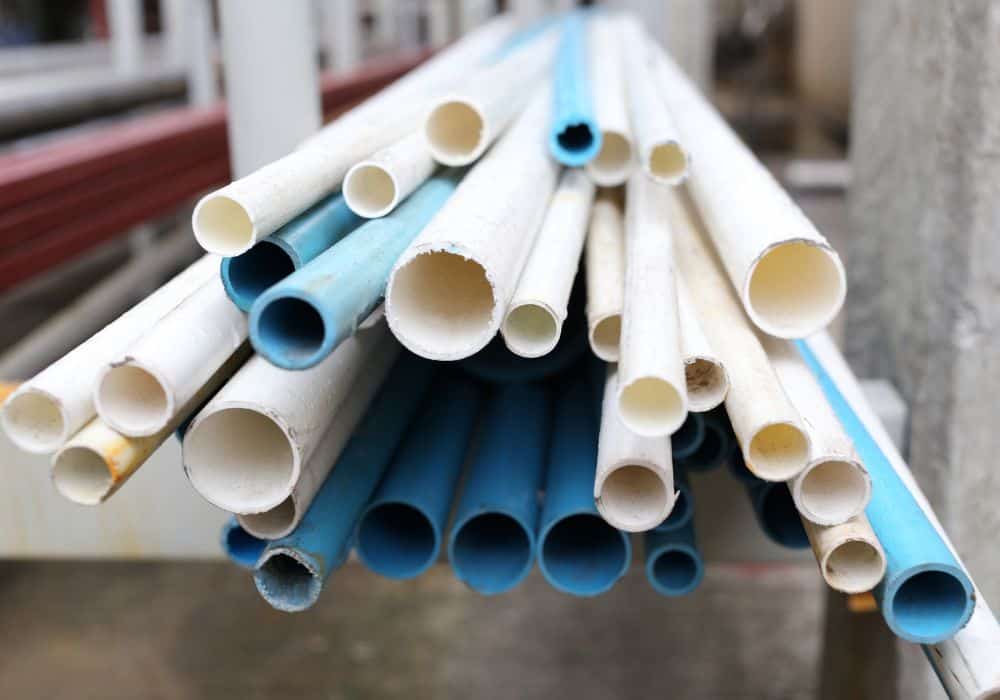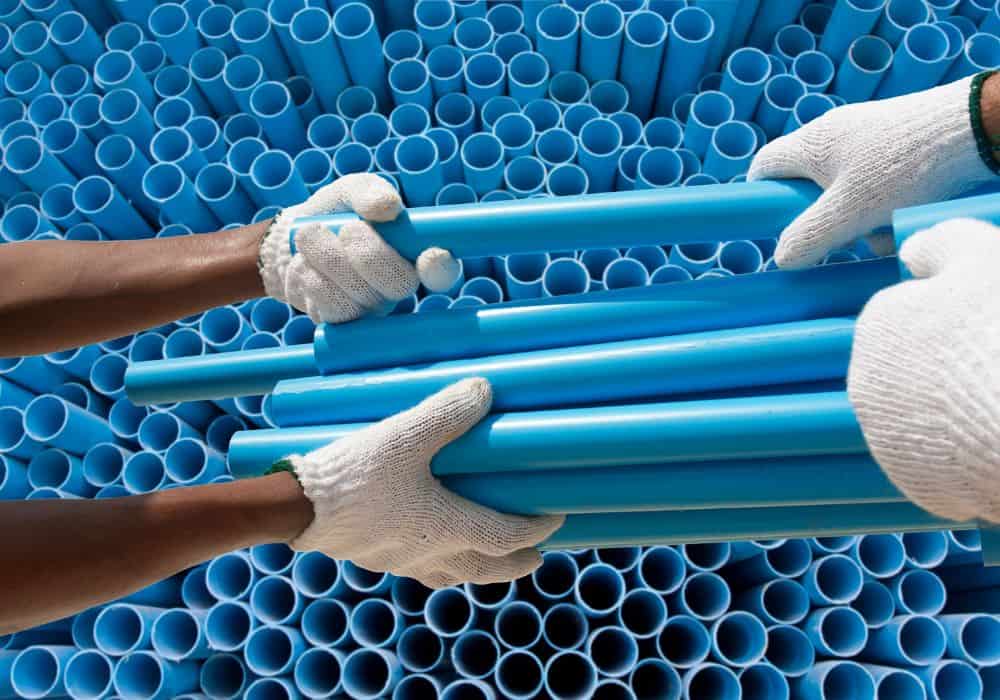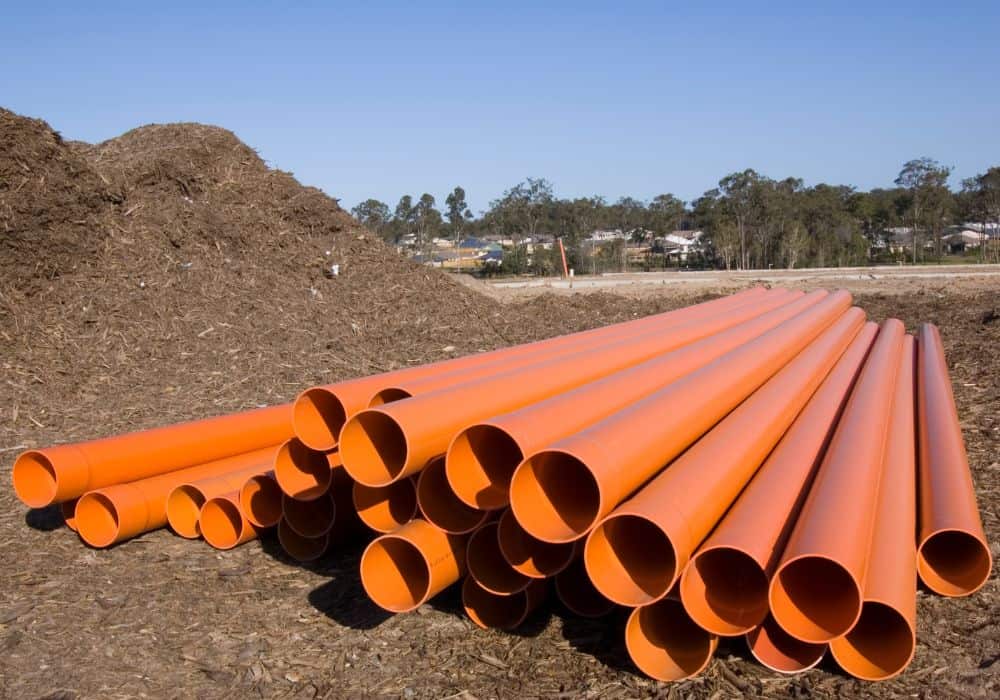PVC pipes are the most commonly used pipes in residential plumbing systems. However, when you need to make plumbing installations or repairs, it may surprise you that a home’s plumbing system uses PVC pipes of different sizes.
That can leave many to as the question of what is the most common PVC pipe size. Well, the answer isn’t a simple one, as different pipes are used for different applications. Read on to find out more as we check out the most common sizes and give you all the info you need.
What Are PVC pipes?

PVC (an acronym for Polyvinyl Chloride) is a plastic material used in plumbing. It is one of the five main types of plumbing pipes, the other types being ABS (acrylonitrile butadiene styrene), copper, galvanized steel, and PEX (cross-linked polyethylene).
PVC pipes are lighter materials, making them easier to work with than other piping options. PVC pipes are commonly used for drain lines of sinks, toilets, and showers. They can handle high water pressure, making them suitable for indoor plumbing, water supply lines, and high-pressure piping.
1. Advantages of PVC pipes
- Durable
- Can withstand high water pressure
- Resistant to rust and corrosion
- Have a smooth surface that makes water flow easily
- Easy to install (welding is not required)
- Relatively inexpensive
2. Disadvantages of PVC pipes
- Not suitable for hot water
- Concerns that PVC may introduce chemicals into drinking water
Most Common PVC Pipes around the Home

Different sizes of PVC pipes are used in different areas of a residential plumbing system. However, the most common ones around a home are 1.5”, 2”, 3”, and 4-inch pipes. So let’s take a closer look at where these pipes are used throughout the home.
1.5” Pipes – The 1.5-inch PVC pipes are commonly used as drainage pipes for kitchen sinks and bathroom vanity or tubs.
2” Pipes – The 2-inch PVC pipes are commonly used as drainage pipes for washing machines and shower stalls. They are also used as vertical stacks for kitchen sinks.
3” Pipes – The 3-inch PVC pipes have many applications. Inside the home, they are commonly used to pipe toilets. Outside the home, 3-inch PVC pipes are commonly used for irrigation (carrying water to and from a garden hose).
4” Pipes – The 4-inch PVC pipes are commonly used as building drains under floors or in crawl spaces to transport wastewater from the home to sewer systems or private septic tanks. 4-inch pipes can also be used as drainage pipes in homes to capture wastewater from two or more bathrooms.
As you can see, it’s very difficult to answer the question of the most common PVC pipe size as all these sizes are used. If you need to replace your pipe and need to know the size, then it’s best that you measure it. Let’s check out how you can do exactly that.
How to Measure PVC Pipe
The nominal scale measurement is used for PVC pipes, which means that the sizes of these plastic pipes are based on their inside diameter (also known as the bore).
So, when measuring the size of a PVC pipe, you start by determining the outside diameter, but the ultimate aim is to arrive at the inner diameter.
That said, the steps to determining the size of a PVC pipe are as below.
- Hold the pipe stationary on a hard surface with one end facing up.
- Use a tape or ruler to measure the distance between the pipe’s left and right exterior edges. This distance is the outer diameter (OD) of the pipe. Keep the ruler as level as possible when measuring.
- Match the measured OD with a PVC pipe sizing chart to determine the corresponding inner diameter.

Know that PVC pipes are labeled with size and schedule. So, when using a PVC sizing chart to determine a pipe’s size, you should use a chart that matches your pipe’s schedule.
A PVC schedule is the thickness of the PVC pipe wall. The different PVC schedules are 20, 40, 80, and 120, with schedules 40 and 80 being the most common. The larger the PVC schedule, the thicker the pipe’s wall.
Thus, schedule 40 and schedule 80 PVC pipes with the same outer diameter will have different inner diameters. The wall of the thicker schedule 80 PVC pipe is thicker from the outside in, resulting in a smaller inner diameter.
The sizing chart for schedule 40 PVC pipes is as follows:
| PVC size (inner diameter) in inches | Outer diameter in inches | The thickness of the pipe’s wall in inches |
| ½ “ | 0.84 | 0.109 |
| ¾ “ | 1.05 | 0.113 |
| 1 “ | 1.315 | 0.133 |
| 1 ¼ “ | 1.66 | 0.14 |
| 1 ½ “ | 1.9 | 0.145 |
| 2 “ | 2.5 | 0.154 |
| 3 “ |
3.5 |
0.216 |
| 3 ½ “ | 4 | 0.226 |
| 4 “ | 4.5 | 0.237 |
| 5 “ | 5.563 | 0.258 |
| 6 “ | 6.625 | 0.28 |
| 8 “ | 8.625 | 0.322 |
| 10 “ | 10.75 | 0.365 |
The sizing chart of Schedule 80 PVC pipes is as below.
| PVC size (inner diameter) in inches | Outer diameter in inches | The thickness of the pipe’s wall in inches |
| ½ “ | 0.84 | 0.147 |
| ¾ “ | 1.05 | 0.154 |
| 1 “ | 1.315 | 0.179 |
| 1 ¼ “ | 1.66 | 0.191 |
| 1 ½ “ | 1.9 | 0.2 |
| 2 “ | 2.5 | 0.218 |
| 3 “ | 3.5 | 0.3 |
| 3 ½ “ | 4 | 0.318 |
| 4 “ | 4.5 | 0.337 |
| 5 “ | 5.563 | 0.375 |
| 6 “ | 6.625 | 0.432 |
| 8 “ | 8.625 | 0.5 |
| 10 “ | 10.75 | 0.594 |
Schedule 40 vs Schedule 80 PVC Pipes
Schedule 40 and 80 are the most common PVC pipes. Schedule 40 finds application in drainage and low-pressure water flow systems, while the thicker schedule 80 pipes find application in pressure pumps requiring stronger PVC pipes.
Schedule 40 and 80 PVC pipes have similar outer diameters so that they can use the same fittings. However, because a schedule 80 pipe has thicker walls, its inner diameter is smaller than that of a similarly-sized schedule 40 pipe.
FAQs
1. Are PVC Pipes Measured By ID Or OD?
Using nominal scale measurement, PVC pipe sizes are named by their internal diameters (ID) and not their outer diameter (OD). That is, for a 2-inch PVC pipe, the bore is 2 inches wide.
The “inner diameter” PVC pipe measure is known as nominal size. The name “nominal” is apt because the measurement is in name only. If you measure the outside diameter of a PVC pipe, you will get a figure larger than the given size (with the thickness of the pipe’s wall accounting for the bigger reading).
2. What Is The Outside Diameter of a 1.5” PVC Pipe?
The external diameter of a 1.5″ PVC pipe depends on the pipe’s schedule (or wall thickness). For example, because of wall thickness, a 1.5 inches schedule 40 PVC pipe used in drainage around the house has outside diameters of 1.9 inches.
From one edge to the other, a 1.5 inches PVC pipe measures 1.9 inches, not 1.5 inches.
3. How Do I Know What Size PVC Pipe I Have?
There are two ways to know the size of your PVC pipe. Firstly, read the manufacturer’s markings on the side of the pipe. Secondly, measure the pipe’s outer diameter (OD) and match the reading with a PVC pipe sizing chart to determine the nominal size.
For the first method, look at the side of the pipe to know its size. Most PVC pipes sold in hardware stores have markings on their sides indicating their sizes. You’ll find them in decimals or fractions (such as 1.25” or 1 ¼”).
For PVC pipes that are not marked, you need to measure the pipe to know what size you have. Use a ruler to measure the outer diameter (the distance from one edge of the pipe to the other), then look up a PVC sizing chart for the nominal size that corresponds to the OD.
4. What Is The Difference Between PVC And CPVC, And Which Is Better?
PVC (Polyvinyl chloride) is the plastic piping widely used in plumbing systems. CPVC (chlorinated polyvinyl chloride) is a variant of PVC produced by the chlorination of PVC.
CPVC pipes have higher chlorine content, increasing their high-temperature threshold. While PVC pipes can withstand temperatures above 140 F, CPVC can withstand temperatures up to 200 F, making them the preferred pipes for transporting hot water in HVAC (Heating, Ventilation, and Cooling) systems.
That said, CPVC pipes are upgraded versions of PVC pipes.
Final Thoughts
PVC pipes are the most common plastic pipes. Being durable and having a smooth inner surface that helps water flow easily, you often find PVC pipes in the sewer, water mains, and irrigation systems. The nominal system measures PVC pipes, with the pipe sizes stated by their internal diameters.
The most common PVC pipe sizes are 1½ inches (used as drain pipes for kitchen sinks, bathroom vanity, and tubs), 2 inches (used as drain pipes for washing machines and shower stalls), 3 inches (used in piping toilets), and 4 inches (used to connect homes to sewer system).
It’s vital to select the right PVC pipe for your needs. Hopefully, this guide has given you all the info you need if you intend to repair or upgrade your home plumbing system.
